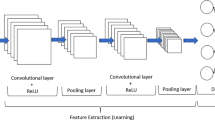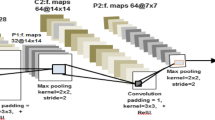Abstract
Data-driven deep learning techniques set the current state of the art in image classification for hyperspectral remote sensing images. The lack of labeled training data and high dimensionality of hyperspectral images, results in these techniques being far from satisfactory with respect to accuracy and efficiency. To address the deficiencies of the existing approaches, we proposed a novel neural network technique, namely, dense residual three-dimensional convolutional neural network (DR-3D-CNN). Tailored for hyperspectral images, this network used 3D convolution instead of the conventional 2D convolution for more effective spectral feature extraction. It also employed dense residual connections to alleviate the problem of gradient dispersion. After the initial classification by the network, the proposed technique further refined the result using multi-label conditional random field optimization. Experimental results on various hyperspectral image datasets showed that the proposed model outperforms existing deep learning techniques with respect to accuracy by a large margin while requiring less training time.














Similar content being viewed by others
References
Bengio Y (2009) Learning deep architectures for AI foundations and trends[J]. Mach Learn 2(1):1–55
Bengio Y, Ducharme R, Vincent P (2001) A neural probabilistic language model. Advances in Neural Information Processing Systems(NIPS), 933–938
Boykov Y, Kolmogorov V (2004) An experimental comparison of min-cut/max-flow algorithms for energy minimization in vision[J]. IEEE Trans Pattern Anal Mach Intell 26(9):1124–1137
Camps-Valls G, Bruzzone L (2005) Kernel-based methods for hyperspectral image classification[J]. IEEE Trans Geosci Remote Sens 43(6):1351–1362
Chang C-I (2007) Hyperspectral data exploitation: theory and applications. John Wiley & Sons, Hoboken
Chen L, Yang M (2017). Semi-supervised dictionary learning with label propagation for image classification[C]. CVM
Chen Y, Nasrabadi NM, Tran TD (2013) Hyperspectral image classification via kernel sparse representation[J]. IEEE Trans Geosci Remote Sens 51(1):217–231
Chen Y, Lin Z, Zhao X, Wang G, Gu Y (2014) Deep learning-based classification of Hyperspectral data[J]. IEEE Journal of Selected Topics in Applied Earth Observations & Remote Sensing 7:2094–2107
Chen Y, Jiang H, Li C, Jia X, Ghamisi P (2016) Deep feature extraction and classification of Hyperspectral images based on convolutional neural networks[J]. IEEE Trans Geosci Remote Sens 54:6232–6251
Cheng-Hsuan L, Bor-Chen K, Chin-Teng L, Chih-Sheng H (2012) A spatial-contextual support vector machine for remotely sensed image classification[J]. IEEE Trans Geosci Remote Sens 50(3):784–799
Dong Y, Zhang Z, Hong W-C (2018) A hybrid seasonal mechanism with a chaotic cuckoo search algorithm with a support vector regression model for electric load forecasting. Energies 11(4):1009
Fauvel M, Chanussot J, Benediktsson JA (2011) A spatial-spectral kernel based approach for the classification of remote sensing images[J]. Pattern Recogn 45(1):281–392
Fulkerson B, Vedaldi A, Soatto S (2009) Class segmentation and object localization with superpixel neighborhoods [J]. Proc IEEE 20(2):670–677
Geiss C, Thoma M, Taubenbock H (2018) Cost-sensitive multitask active learning for characterization of urban environments with remote sensing[J]. IEEE Geoscience & Remote Sensing Letters 99:1–5
Ghamisi P, Benediktsson JA, Sveinsson JR (2014) Automatic spectral-spatial classification framework based on attribute profiles and supervised feature extraction[J]. IEEE Trans Geosci Remote Sens 52(9):5771–5782
Ghamisi P, Benediktsson JA, Cavallaro G, Plaza A (2014) Automatic framework for spectral-spatial classification based on supervised feature extraction and morphological attribute profiles[J]. IEEE Journal of Selected Topics in Applied Earth Observations and Remote Sensing 7(6):2147–2160
Glorot X, Bengio Y (2010) Understanding the Difficulty of Training Deep Feedforward Neural Networks[J]. In Proceedings of the 13th International Conference on Artificial Intelligence and Statistics, AISTATS 2010, Sardinia, Italy 5:249–256
Gong C, Tao D, Wei L et al. (2015) Saliency propagation from simple to difficult[C]. CVPR
Gu Y, Wang C, You D, Zhang Y, Wang S, Zhang Y (2012) Representative multiple kernel learning for classification in hyper-spectral imagery[J]. IEEE Trans Geosci Remote Sens 50(7):2852–2865
He K, Zhang X, Ren S et al (2015) Delving Deep into Rectifiers: Surpassing Human-Level Performance on ImageNet Classification[J]. In Proceedings of the 15th IEEE International Conference on Computer Vision, ICCV 2015 12:1026–1034
Heeker C et al (2008) Assessing the influence of reference spectral on synthetic SAM classification results[J]. IEEE Trans Geosci Remote Sens 46(12):4162–4172
Hinton G, Salakhutdinov R (2006) Reducing the dimensionality of data with neural networks[J]. Science 313(5786):504–507
Hinton G, Osindero S, Teh Y-W (2006) A fast learning algorithm for deep belief nets[J]. Neural Comput 18(7):1527–1554
Hong WC, Li MW, Geng J, Zhang Y (2019) Novel chaotic bat algorithm for forecasting complex motion of floating platforms. Appl Math Model 72:425–443
Hsieh PF (2009) Impact and realization of increased classes separability on the small sample size problem in the hyperspectral classification[J]. Can J Remote Sens 35(3):248–261
Huang G, Liu Z, Weinberger KQ (2017) Densely Connected Convolutional Networks[J]. In Proceedings of the 2017 IEEE conference on pattern recognition and computer vision(CVPR), College Park, MD, USA 6:1–9
Ioffe S, Szegedy C (2015) Batch Normalization: Accelerating Deep Network Training by Reducing Internal Covariate Shift[J]. In Proceedings of the 32nd International Conference on Machine Learning, ICML 2015 7:1–9
Jia X, Richards JA (1994) Effieient maximum likelihood classification for imaging spectrometer datasets[J]. IEEE Trans Geosci Remote Sens 32(2):274–281
Keren F, Zhao Q, Gu IY-H, Yang J (2019) Deepside: A general deep framework for salient object detection[J]. Neurocomputing 356(13):69–82
Kingma D, Ba J (2014) Adam: a method for stochastic optimization[J]. Computer Science
Krizhevsky A, Sutskever I, Hinton GE (2012) ImageNet Classification with Deep Convolutional Neural Networks[J]. In Proceedings of the 26th Annual Conference on Neural Information Processing Systems 2012 12:1097–1105
Kundra H, Sadawarti H (2015) Hybrid algorithm of cuckoo search and particle swarm optimization for natural terrain feature extraction. Res J Inf Technol 7:58–69
Li J, Bioucas-Dias JM, Plaza A (2013) Spectral-spatial classification of hyperspectral data using loopy belief propagation and active learning[J]. IEEE Trans Geosci Remote Sens 51(2):844–856
Li J, Zhang H, Zhang L (2014) Supervised segmentation of very high resolution images by the use of extended morphological attribute profiles and a sparse transform[J]. IEEE Geosci Remote Sens Lett 11(8):1409–1413
Li Y, Zhang H, Shen Q (2016) Spectral-spatial classification of Hyperspectral imagery with 3D convolutional neural network[J]. Remote Sens 8:438–447
Li Y, Zhang H, Shen Q (2017) Spectral-spatial classification of Hyperspectral imagery with 3D convolutional neural network[J]. Remote Sens 9:67
Makantasis K, Karantzalos K, Doulamis A et al (2015) Deep Supervised Learning for Hyperspectral Data Classification through Convolutional Neural Networks[J]. In Proceedings of the 2015 IEEE International Geoscience and Remote Sensing Symposium 6:4959–4962
Meyer A, Paglieroni D, Astaneh C (2003) K-means reclustering: algorithmic options with quantifiable performance comparisons[J]. Proc SPIE 5001:84–92
Moser G, Serpico SB (2013) Combining support vector machines and Markov random fields in an integrated framework for contextual image classification[J]. IEEE Trans Geosci Remote Sens 51(5):2734–2752
Moser G, Serpico SB, Benediktsson JA (2013) Land-cover mapping by Markov modeling of spatial-contextual information in very-high-resolution remote sensing images[J]. Proc IEEE 101(3):631–651
Murray NJ, Keith DA, Simpson D et al (2018) Remap: an online remote sensing application for land cover classification and monitoring[J]. Methods Ecol Evol 9:1–9
Nie G-Y, Cheng M-M, Liu Y, Liang Z, Fan D-P, Liu Y, Wang Y (2019) Multi-Level Context Ultra-Aggregation for Stereo Matching, CVPR
Pinto N, Doukhan D, Dicarlo J et al (2009) A high-throughout screening approach to discovering good forms of biologically inspired visual representation[J]. PLoS Comput Biol 5(11):e1000579
Song B, Li J, Dalla Mura M et al (2014) Remotely sensed image classification using sparse representations of morphological attribute profiles[J]. IEEE Transactions on Geoscience & Remote Sensing 52(8):5122–5136
Srivastava N, Hinton G, Krizhevsky A et al (2014) Dropout: a simple way to prevent neural networks from Overfitting[J]. J Mach Learn Res 15:1929–1958
Willett RM, Duarte MF, Davenport MA, Baraniuk RG (2014) Sparsity and structure in hyperspectral imaging: sensing, reconstruction, and target detection[J]. IEEE Signal Process Mag 31(1):116–126
Zhang Z-C, Hong W-C (2019) Electric load forecasting by complete ensemble empirical model decomposition adaptive noise and support vector regression with quantum-based dragonfly algorithm. Nonlinear Dynamics 98:1107–1136
Zhang L, Tao D, Huang X (2012) On combining multiple features for hyperspectral remote sensing image classification[J]. IEEE Trans Geosci Remote Sens 50(3):879–893
Zhang L, Tao D, Huang X (2013) Tensor discriminative locality alignment for hyperspectral image spectral-spatial feature extraction[J]. IEEE Trans Geosci Remote Sens 51(1):242–256
Zhao W, Du S (2016) Spectral-spatial feature extraction for Hyperspectral image classification: a dimension reduction and deep learning approach[J]. IEEE Trans Geosci Remote Sens 54:4544–4554
Zhao WZ, Du SH (2016) Learning multiscale and deep representations for classifying remotely sensed imagery[J]. ISPPS Journal of Photogrammetry and Remote Sensing 113:155–165
Zhao JX, Liu J, Fan DP et al. (2019) EGNet:edge guidance network for salient object detection[J]
Acknowledgments
This work was supported by National Natural Science Foundation of China (61705019).
Author information
Authors and Affiliations
Contributions
Data curation, Suting Chen; Methodology, Meng Jin; Supervision, Suting Chen and Jie Ding; Writing – original draft, Meng Jin; Writing – review & editing, Suting Chen and Meng Jin.
Corresponding author
Ethics declarations
Conflict of interest
There is no conflict of interest.
The authors declared that they have no conflicts of interest to this work.
We declare that we do not have any commercial or associative interest that represents a conflict of interest in connection with the work submitted.
Additional information
Publisher’s note
Springer Nature remains neutral with regard to jurisdictional claims in published maps and institutional affiliations.
Rights and permissions
About this article
Cite this article
Chen, S., Jin, M. & Ding, J. Hyperspectral remote sensing image classification based on dense residual three-dimensional convolutional neural network. Multimed Tools Appl 80, 1859–1882 (2021). https://doi.org/10.1007/s11042-020-09480-7
Received:
Revised:
Accepted:
Published:
Issue Date:
DOI: https://doi.org/10.1007/s11042-020-09480-7




